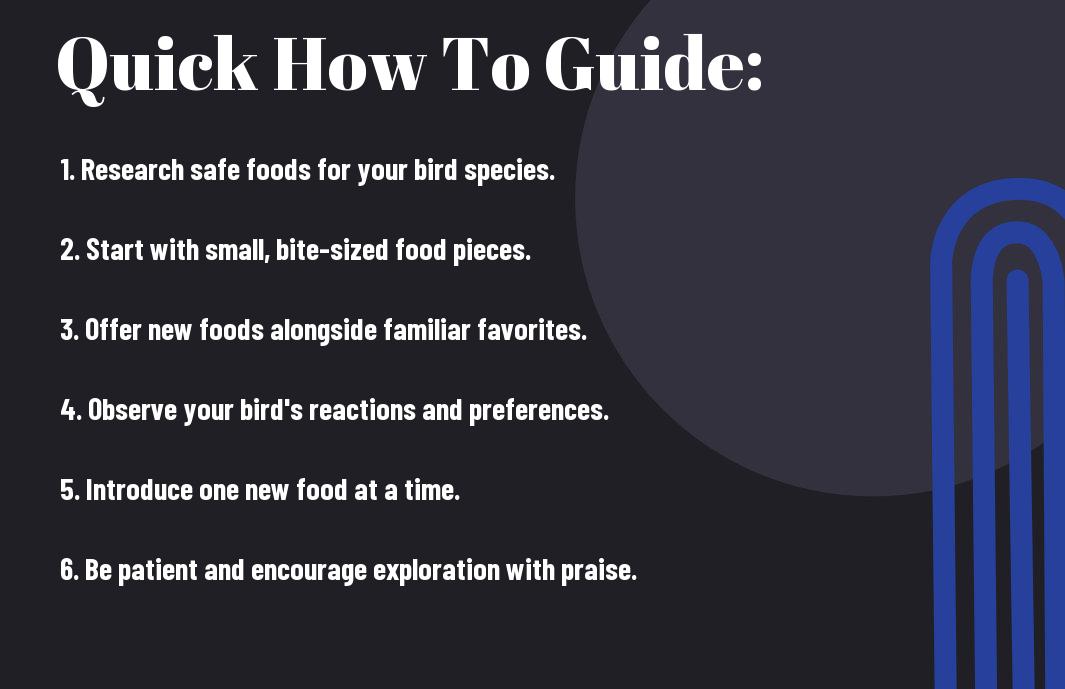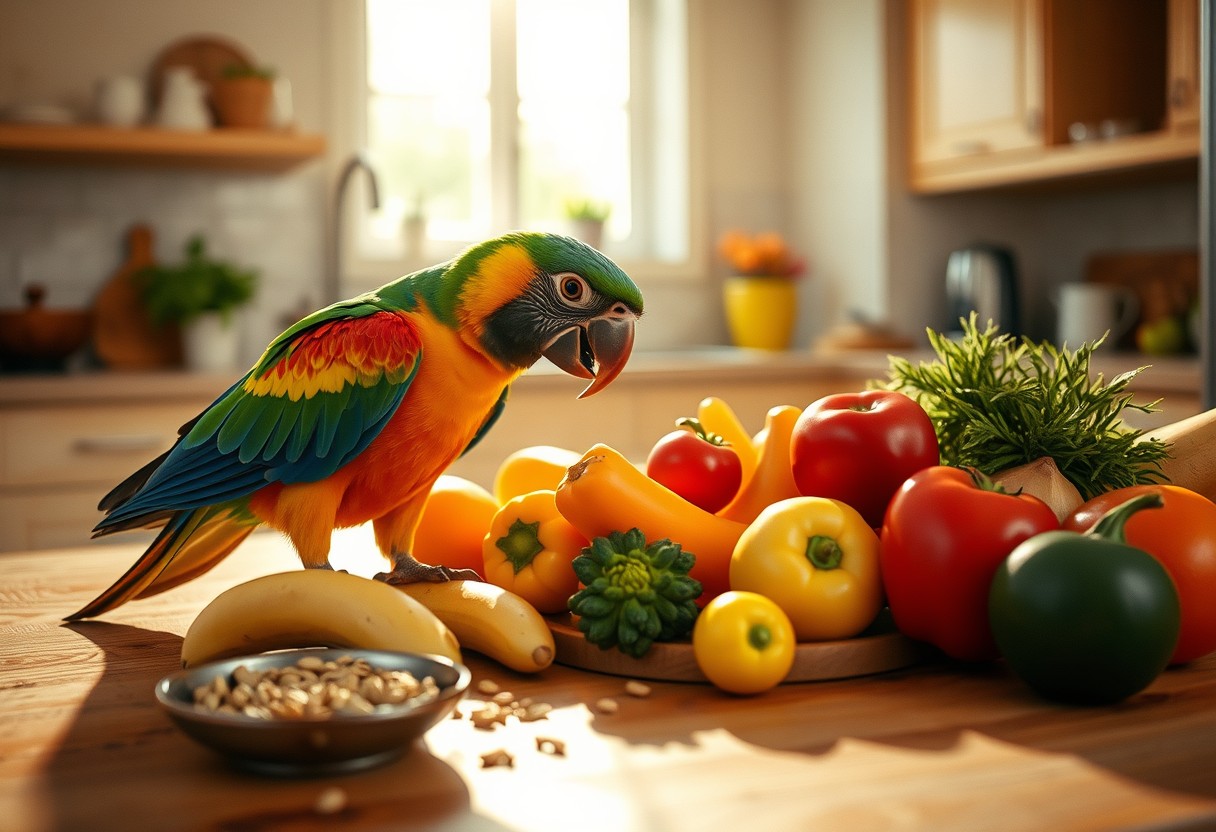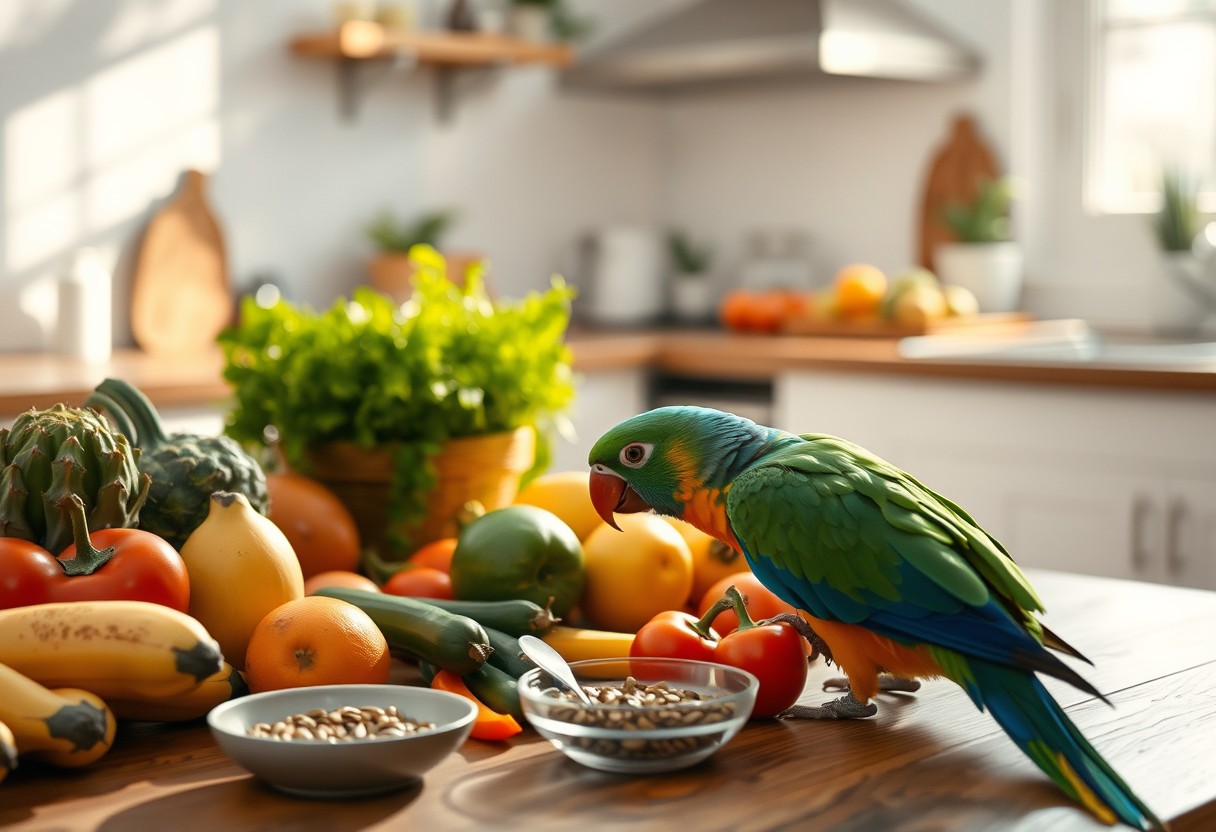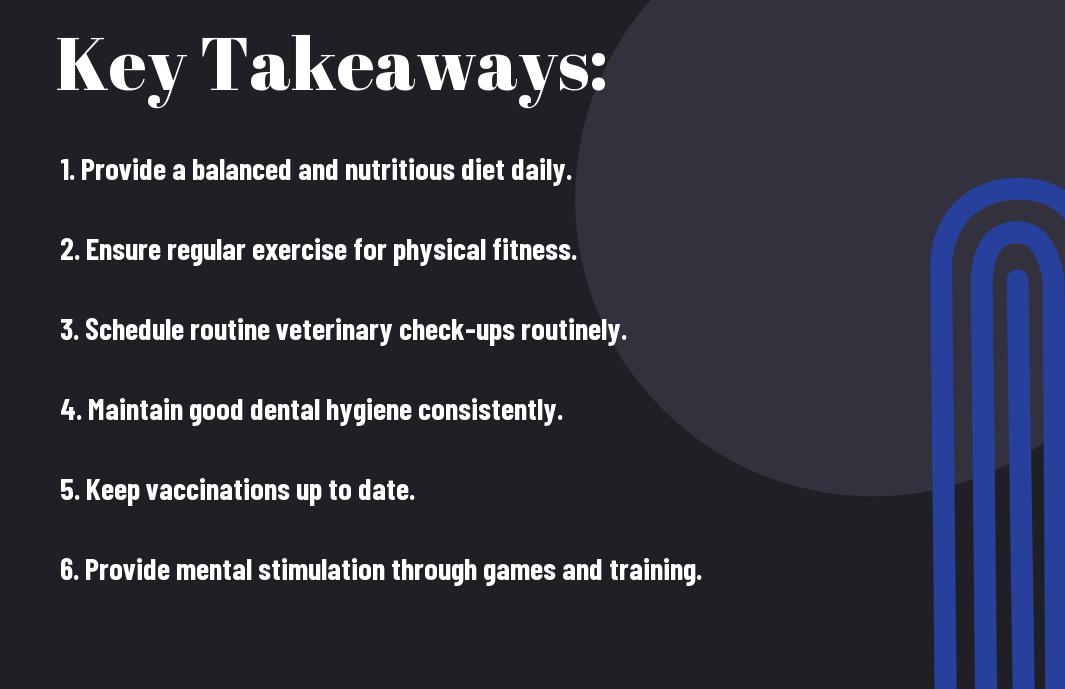Introduce your feathered friend to new and exciting foods to enhance its diet and overall health. It’s important to do this gradually to avoid digestive issues or rejection. Start by offering small samples of safe fruits and vegetables and monitor your bird’s reaction closely; some ingredients may be toxic to birds. Be patient and persistent, as it may take several attempts before your bird embraces new tastes. Note, a balanced diet contributes to your bird’s longevity and well-being, so take your time with this crucial process.

Understanding Your Bird’s Diet
The right diet is crucial for your bird’s overall health and well-being. This means it’s crucial to not only provide a balanced diet but also to ensure that your bird is exposed to a variety of foods. Birds are natural foragers, and as such, they thrive when they can explore different textures, flavors, and nutrients in their meals. Understanding your bird’s dietary needs will empower you to make informed choices that promote their health and happiness.
Importance of Nutritional Variety
One of the key components of avian nutrition is ensuring nutritional variety. A diverse diet will not only supply the necessary vitamins and minerals but will also ensure that your bird remains interested in food, reducing the likelihood of developing picky eating habits. Variety plays a vital role in preventing nutritional deficiencies that could lead to serious health issues. By introducing a range of fruits, vegetables, grains, and even some protein sources, you can create a holistic meal plan for your feathered friend.
Moreover, a varied diet can mimic the natural foraging behavior of wild birds, making mealtime an enriching experience. Offering different foods can stimulate your bird both mentally and physically. By providing options, you encourage your bird to engage with their environment, which is beneficial for their overall mental health. In essence, allowing your bird to enjoy an assortment of foods will help maintain their physical and emotional well-being.
Factors Influencing Food Preferences
Birds, like humans, have their unique food preferences that can be influenced by several factors. These include age, species, previous exposure, and even individual temperament. Young birds may be more adventurous in trying new foods, while older birds might have established preferences that are harder to shift. Some species might naturally be attracted to seeds and nuts, while others could show an inclination towards fruits and veggies. Learning about your bird’s specific tendencies will arm you with the knowledge needed to introduce new dietary items effectively.
- Age – Younger birds tend to be more open to experimentation with new foods.
- Species – Different species exhibit varying dietary needs and preferences.
- Past experiences – Birds may develop a taste or aversion based on their past exposure to certain foods.
- Individual personality – Some birds are more curious and adventurous than others.
Birds can be quite sensitive to their environments, and various factors can significantly impact their food habits. Exposure to certain foods during critical developmental stages can shape lifelong preferences. If your bird has been primarily fed a seed-based diet, transitioning them to fresh fruits and veggies can take time and patience. Start by introducing small amounts of new foods alongside their usual diet, making adjustments based on how they respond. Monitor for signs of disinterest or discomfort, and make the process enjoyable to help foster positive experiences with new foods. Thou, educating yourself about their food habits is an invaluable step in enhancing their diet.
Preferences and Safety
Preferences can also be influenced by social interactions, as birds often learn from watching others, especially in multi-bird households. Introducing different types of foods can be a great opportunity for hybrid meals where birds might see their companions trying something new, and that might pique their interest. However, it is important to keep in mind that not all foods are safe. Certain foods can be toxic to birds, so you must do your research. Pay attention to which foods are harmful for your bird, including avocado, chocolate, and certain seeds. Ensuring that your bird enjoys a healthy, palatable, and safe diet is vital. Thou, staying informed about proper avian care can truly make a difference in your bird’s health and longevity.

Most bird owners want to ensure their feathered friends have a nutrient-rich diet that fosters good health and longevity. Introducing your bird to new foods can be exciting, but it’s crucial to do it correctly to avoid potential digestive issues. With patience and a strategic approach, you can safely expand your bird’s palate while offering new flavors and textures. This guide will walk you through the vital steps to encourage your bird to try different foods without stress or risk.

Tips for Successful Transition
Now that you are ready to introduce new foods to your bird, it’s important to ensure that the transition is smooth and successful. Implementing a few key strategies can greatly enhance the likelihood that your feathered friend will embrace the change. Here are some tips you can follow:
- Introduce new foods gradually alongside their regular diet.
- Observe **texture** and **color** preferences when selecting new foods.
- Be patient and allow your bird to explore new foods at their own pace.
- Use **positive reinforcement** when your bird tries new items.
- Prepare food in different forms, such as chopped, pureed, or whole, to pique their interest.
The transition to new foods can be both exciting and a little intimidating for your bird; however, the above tips will help ensure that the experience is enjoyable for both you and your feathered companion.
Monitoring Behavioral Changes
Transitioning your bird to new foods means you must be vigilant in monitoring their **behavioral changes**. Birds can be sensitive to changes in their diet, which might manifest through alterations in their **activity level**, **vocalization**, or even changes in **preening habits**. If you notice that your bird seems less active or displays signs of distress during the transition, it may be crucial to revert back to their **previous diet** temporarily and reassess your approach.
Additionally, keep an eye on their droppings for any signs of digestive distress. Changes in color or consistency can be an indicator that your bird is struggling to adapt to new foods. Should you observe worrying changes, consult with an avian veterinarian for advice tailored specifically to your bird’s needs.
Encouraging Exploration and Curiosity
Tips for encouraging your bird to explore new food options can significantly benefit the transition process. Understanding your bird’s natural curiosity will help you present new foods in a way they find inviting. Start by **offering foods** in a separate area where your bird feels comfortable, and allow them to investigate the new items at their own pace. You can also engage them through **interactive feeding**, such as hiding treats among their toys or foraging opportunities, making it easier for them to associate new foods with positive experiences.
Plus, you can enhance their interest by introducing **variety** and **novelty** in presentation. **Birds** are often drawn to bright colors and interesting shapes, so consider arranging new foods in an appealing manner. Mixing **fresh fruits** and **vegetables** into their favorite foods can also entice them to experiment with new flavors. Ensuring that you maintain a **positive** feeding atmosphere will encourage your bird to be adventurous. The key to a successful transition lies in patience and creativity.
Troubleshooting Food Refusal
Despite your best efforts, your bird may still refuse to try new foods. This can be frustrating, especially when you want to ensure that your feathered friend receives a balanced diet. Understanding the underlying reasons for this hesitation can help you adjust your approach and encourage your bird to be more adventurous in its eating habits.
Common Reasons for Rejection
You may find that your bird is rejecting new foods for a variety of reasons. One common issue is the familiarity bias; your bird may be accustomed to the same foods and wary of trying unfamiliar options. Additionally, some birds can be picky eaters, exhibiting a strong preference for textures or flavors they already know. Stress or changes in their environment, such as moving to a new home or encountering noisy activities, can also lead to food refusal.
Another reason for rejection could stem from a bird’s natural instincts. In the wild, birds often learn what is safe and beneficial to eat from their parents. If they are not exposed to diverse foods early on, they might not recognize new foods as safe or edible. This means that patience and positive reinforcement are crucial in helping your bird adjust to new dietary options.
Solutions to Overcome Hesitation
Little changes in your feeding strategy can make a significant difference in your bird’s willingness to try new foods. Start by offering new options alongside their favorite treats, allowing your bird to explore at its own pace. Keeping a positive, stress-free environment during mealtime can also encourage them to sample different foods. Use enthusiastic vocalizations or even mimic their sounds when introducing new items to spark curiosity.
For instance, you might consider gradually mixing new foods into their regular diet. Start with small amounts, ensuring you maintain their favorite staples as well. If your bird shows interest, reward them with a small treat or affection, fostering a positive association with the new food. Be consistent in your attempts, as some birds may need time to warm up to new options. Above all, patience is key, and creating a safe and encouraging atmosphere will help your bird feel secure in trying new foods without undue stress.
Final Words
Ultimately, introducing your bird to new foods requires patience, careful observation, and a willingness to experiment. By presenting a variety of options, from colorful fruits and vegetables to high-quality pellets and occasional treats, you not only enhance your bird’s diet but also stimulate their natural curiosity. It’s important to monitor their reactions, as some birds may take longer than others to embrace new flavors. Remember to take the process slowly and celebrate small victories to keep your bird motivated and engaged.
As you commence on this culinary journey with your feathered friend, always prioritize a balanced and nutritious diet. Ensure that you are providing foods that are safe and healthy for your specific bird species. By encouraging a love for new foods while maintaining a stable routine with their preferred items, you can foster a positive eating experience that supports their overall well-being. With time, patience, and your careful guidance, your bird will become more adventurous in their culinary choices, ultimately leading to a happier and more robust companion.
FAQ
Q: Why is it important to introduce new foods to my bird?
A: Introducing new foods to your bird is crucial for their overall health and well-being. A varied diet ensures they receive imperative nutrients, vitamins, and minerals. Birds that only eat the same food every day may develop nutritional deficiencies or become bored with their diet, which can lead to health issues or behavioral problems. By incorporating a wide range of fruits, vegetables, grains, and healthy treats, you can promote better nutrition and help keep your bird mentally stimulated.
Q: What is the best method for introducing new foods to my bird?
A: The best method for introducing new foods is to start slowly and be patient. Begin by offering small portions of the new food alongside your bird’s regular diet. Make sure to observe your bird’s reaction to the new items. If they show interest, encourage them by offering the food again in future meals. You can also try different textures and forms, such as cooked versus raw, or cutting foods into small pieces. Positive reinforcement, such as praise or a favorite treat, can also help your bird feel more comfortable with the new offerings.
Q: What should I do if my bird refuses to eat new foods?
A: If your bird refuses to eat new foods, don’t be discouraged. Birds can be very particular about their food preferences, and it may take multiple attempts before they accept a new item. Try offering the new food at different times of the day or in different locations within their cage. You can also mix new foods with familiar ones or try different presentation styles, like skewering fruits and veggies or using foraging toys. Additionally, make sure to remove any uneaten food after a few hours, as birds may prefer fresh food versus leftovers. Always ensure your bird’s regular diet is still well-balanced and that they are getting adequate nutrition while you explore new options.











